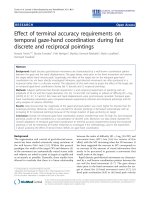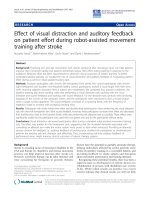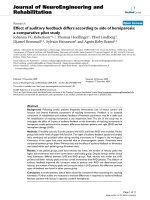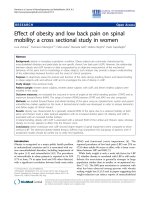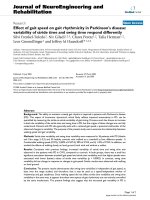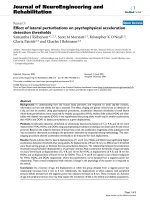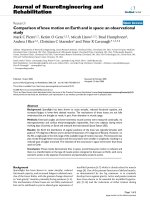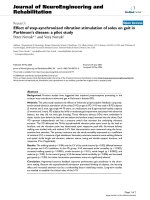báo cáo hóa học:" Effect of adaptive abilities on utilities, direct or mediated by mental health?" pot
Bạn đang xem bản rút gọn của tài liệu. Xem và tải ngay bản đầy đủ của tài liệu tại đây (279.52 KB, 8 trang )
RESEARC H Open Access
Effect of adaptive abilities on utilities, direct or
mediated by mental health?
Yvette Peeters
1*
, Adelita V Ranchor
2
, Thea PM Vliet Vlieland
3
, Anne M Stiggelbout
1
Abstract
Background: In cost-utility analyses gain in health can be measured using health state utilities. Health state utilities
can be elicited from members of the public or from patients. Utilities given by patients tend to be higher than
utilities given by members of the public. This differe nce is often suggested to be explained by adaptation, but this
has not yet been investigated in patients. Here, we investigate if, besides health related quality of life (HRQL),
persons’ ability to adapt can explain health state utilities. Both the direct effect of persons’ adaptive abilities on
health state utilities and the indirect effect, where HRQ L mediates the effect of ability to adapt, are examined.
Methods: In total 125 patients with Rheumatoid Arthritis were interviewed. Participants gave valuations of their
own health on a visual analogue scale (VAS) and time trade-off (TTO). To estimate persons’ ability to adapt, patients
filled in questionnaires measuring Self-esteem, Mastery, and Optimism. Finally they completed the SF-36 measuring
HRQL. Regression analyses were used to investigate the direct and mediated effect of ability to adapt on health
state utilities.
Results: Persons’ ability to adapt did not add considerably to the explanation of health state utilities above HRQL.
In the TTO no additional variance was explained by adaptive abilities (Δ R
2
= .00, b = .02), in the VAS a minor
proportion of the variance was explained by adaptive abilities (Δ R
2
= .05, b = .33). The effect of adaptation on
health state utilities seems to be mediated by the mental health domain of quality of life.
Conclusions: Patients with stronger adaptive abilities, based on their optimism, mastery and self-esteem, may
more easily enhance their mental health after being diagnosed with a chronic illness, which leads to higher health
state utilities.
Background
In health care, decisions are made about treatment at the
level of individual patients, of patient groups (guideline
development), and at the societal level [1]. Decisions
about guideline development and decisions at the societal
level are often guided by cost-utility analyses. In these
analyses the gain in health obtained by treatment is com-
pared with the costs that have t o be made in order to
obtain this gain [2]. To assess the value of this gain, cost-
utility analyses make use of health state valuations, i.e.
health state utilities.
A health state utility i s a preference for a particular
health state compared with perfect health and immediate
death. Utilities can be seen as a global valuation of health
related quality of life (HRQL) [3] and can be expected to
show a strong relationship withhealthstatus.Neverthe-
less, on ly between 18% and 43% of the variance in health
state utilities can be explained by HRQL. Most of the var-
iance still remains unexplained [4].
Health state utilities can be elicited from members of the
public and from patients. M embers of the public tend to
give lower health state valuations, compared to patients
[5]. This discrepancy in health state valuations has, among
others, been suggested to be explained by the fa ilure of
members of the public to anticipate on their ability to
adapt. Patients adapt to the physical and psychological
challenges of their illness [6]. When health state valuations
are elicited from patients, some of the variance in health
state utilities might be explained by this adaptation [7-9].
Tentative support has been found for the effect of
adaptation on health state valuations. Members of the
public who were made aware of their ability to adapt
* Correspondence:
1
Department of Medical Decision Making, Leiden University Medical Centre,
Leiden, The Netherlands
Full list of author information is available at the end of the article
Peeters et al. Health and Quality of Life Outcomes 2010, 8:130
/>© 2010 Peeters et al; licensee BioMed Central Ltd. This is an Open A ccess article distribu ted under the terms of the Creative Commons
Attribution License ( which permits unrestricted use, distribution, and re production in
any mediu m, provided the original work is properly cited.
gave higher valuations on a person trade-off (PTO) and
on a visual analogue scale (VAS) measuring quality of life
[10,11], but not on the time trade-off (TTO) nor on the
standard gamble (SG) [12]. Whether health state utilities
given by patients are actually correlated with adaptation
has not been topic of study yet.
Adaptation can be defined as a response that diminishes
or remains the same despite constant or increasing stimu-
lus levels [13]. The outcome of adaptation can be mea-
sured by change over time, such as change in well-being
[14] or life satisfaction [15,16]. If researcher s aim to gai n
more insight in the process of adaptation itself, adaptation
can be conceptualise d through certain coping-strategie s
[17,18]. These coping-strategies are, among others,
enabled by p ersonal r e sources.
By studying adaptation Taylor [19] developed the Cogni-
tive Adaptation Theory (CAT) which is based on cognitive
interviews with chronically ill persons. This theory is one
of the dominant theories in health psychology and has
often been used to empirically test adaptation. Research
using this theory suggests that psychological adjustment to
an illness occurs around four themes; a search for mean-
ing in the experience, an attempt to regain mastery over
the event and over one’slifemoregenerally,aneffortto
enhance one’s self-est eem, and the ability to find positive
illusions, i.e. optimism. These concepts as suggested in the
CAT are further described below.
After a threatening event, people often ca nnot find a
sense of meaning in the experience and lose their feelings
of mastery and of self-esteem. Mo st people manage to
re-establish these over time. According to Taylor, this re-
establishment is based on so-called positive illusions.
People develop unre alistic beliefs that make it possible to
regain control over the event and over one’slifeandto
regain self-esteem [19]. Although positive illusions may
create unrealistic and maybe ‘false’ ideas, these illusions
have been found to be important resources [20].
Previous studies have shown that patients who score
high on indicators of CAT have better psychological
functioning [21-24], they are less anxious and depressed,
report more vitality and have a better mental function-
ing [22,25,26]. Moreover, patients with a higher score
on indicators of CAT reported better physical function-
ing [22,23], they showed fewer new coronary events or
hospital admissions [21,26] and lived longer [27]. It thus
appears that patients who have higher self-esteem, mas-
tery, and optimism, and who find a meaning in the
experience have better abilities to adapt.
No standard method is available for investigating the abi l-
ity to adapt based on C AT. Studies have used different indi-
cators and methods f or thei r analyses. For in stance, studi es
have included indicators measuring optimism, mastery and
self-esteem, but often exclude finding meaning. To our
knowledge, only in two s tudies the effect of finding meaning
was included [27,28]. The rationale to exclude benefit find-
ing was described by Major et al. [29] and Chan et al. [23].
Both research groups suggest that mastery, self-esteem, and
optimi sm are stable personality traits representing a per-
sons’ resilience, whereas finding meaning might be seen as
a p rocess f acilitated by these personality traits.
Apart from this variety of indicators of CAT included
to measure adaptive abilities, studies have also used dif-
ferent ways to measure these indicators. Some studies
have analysed the effects of the different ind icators sepa-
rately [25,30], some have created a s cale taking the indi-
cators together [26-28,31], and again others have
investigated each indicator separately as well as an aggre-
gate scale of the indicators together [21-23]. The latter
studies revealed that besides the effect of the aggregate
scale, often only one of the indicators had an effect on
the outcome measurement. Since the overall results of
these studies show different ‘ single ’ indicators to reveal
an effect, indicators of persons’ abilities to adapt cannot
be simplified to one single indicator. Exploring the results
of these studies further, it seems that significant effects
have mostly been seen in studies using an aggregate
scale. Therefore, in the present study persons’ ability to
adapt is constructed with an aggregate scale based on
mastery, self-esteem and optimism.
The first aim of this study was to investigate if above
HRQL, persons’ adaptive abilities explain health state
utilities. That is:
Do adaptive abilities account for the unexplained
variance in health state utilities above the variance
explained by HRQL?
Another possibility is that adaptation, in this study
measured through persons’ ability to adapt, has an indir-
ect effect on utilities, through HRQL. As described
above, adaptive abilities does affect psychological and
physical functioning [26]. This would fit the hierarchical
model of Spilker and Revicki [32], in which three levels
of quality of life are distinguished t hat h ave mutual
impact on each other. The hierarchy of this model ranged
from a global level such as a health state utility, to HRQL
domains, and to specific determinants of domains such
as personality characteristics, [32] which may include
adaptive abili ties. Thus, the second aim of this study was
to investigate if adaptive abilities affect health state utili-
ties via HRQL domains.
Is the relation between adaptiv e abilities and health
state utilities mediated by HRQL domains [33]?
Since we investigated psychological adaptive abilities
we assume from a theoretical point of view that only
mental health can mediate this relation.
Peeters et al. Health and Quality of Life Outcomes 2010, 8:130
/>Page 2 of 8
Methods
Participants and design
We chose to study our research questions in a sample
of patients with rheumatoid arthritis (RA). RA con-
cerns a chronic disease with a wide spectrum of mani-
festations, for which adaptation is relevant, since no
cure is av ailable. From the database of the Leiden Uni-
versity Medical Centre, 300 people who were between
18 and 76 years old and had visited their treating rheu-
matologist in the previous six months were randomly
selected. In total 1054 patients had visited their rheu-
matologist in the past six months. These patients were
randomly numbered. First, 400 numbers had been
drawn (using the software Excell) as a selection for a
different study [34]. Of the remaining 654 patients 90
patients had to be excluded due to age restrictions,
and 10 were excluded because they had refused to par-
ticipate in a similar study [35]. Next, to get equal
male/female distribution, 150 male patients and 150
female patients were randomly selected to participate
in the current study. Based on the medical records, 50
people who had not been diagnosed with RA, and
seven with severe co-morbid conditions were excluded.
The remaining 243 eligible people received information
about the survey by mail, including an informed con-
sent form. Patien ts who did not return the inf ormed
consent form within three weeks were called as a
reminder. Data were collected using self-report ques-
tionnaires and a semi-structured interview. The medi-
cal ethics committee of the Leiden University Medical
Centre approved the study protocol.
The interview
Face-to-face interviews were performed by three trained
interviewers following a strict interview protocol. The
interviews took place at the persons’ preferred location;
at home, i n the hospital, or at work. A full description
of the interview can be found elsewhere [36]. Here, only
the part of the interview used to gathe r the information
necessary for this study is described.
At the beginning of the interview, people valued
their health of the previous week using a v isual analo-
gue scale (VAS) and a time tradeoff (TTO). Next peo-
ple completed three questionnaires: the EQ-5D
questionnaire [37], two scales of the Patient Satisfac-
tion Questionnaire [38] and, the Rosenberg Self-
Esteem Scale [39]. In this study only the information
retrieved by the Rosenberg Self-Esteem Scale will be
used. After the interview, people were asked to com-
plete a questionnaire at home to lessen the burden.
Among others this questionnaire included the Life
Orientation Test [40], the Mastery scale of Pearlin and
Schooler [41], and the MOS 36-item Short-From
Health Survey (SF-36) [42].
Instruments
The Visual Analogue Scale (VAS)
The VAS is a 100 mm horizontal line ranging from
death to perfect health. Perfect he alth was described as
full well-being in physical, psychological, and social
functioning. Utility for the own health state of last week
was elicited by asking respondents to place a mark
between death and perfect health.
The Time tradeoff (TTO)
The computer program Ci3 [43] was used to elicit the
TTO utilities based on a ping-pong search procedure.
On the computer screen a short description of perfect
health and a description of the patient’ sownhealth
state of the previous week were presented. Perfect health
was again descri bed as full well-being in physical, psy-
chological and social functioning. People rated how
many years (x) of their remaining life expectancy (y),
derived from Dutch life expectancy tables [44], they
were willing to trade to obtai n pe rfect health. Life
expectancy was used as the time frame since it was
showntobemoremeaningfultotheparticipant[45]
and to lead to less loss aversion [46]. Utility was calcu-
lated as
()yx
y
−
.
Indicators for persons’ adaptive abilities
Personal Control
The Mastery List of Pearlin and Schooler [41] measures
the extent to which people feel they are in control of
their lives. People indicated their agreement with seven
items such as “IcandoaboutanythingIreallysetmy
mind to do”, on a five-point Likert scale r anging from
‘ totally disagree’ to ‘ totally agree’. Total score ranged
from 7-35, with a higher score indicating more control.
Good internal consistency (alpha = .58 - .70) was
reported previously among patients with a chronic
illness [47].
Self-Esteem
With the Rosenberg self-esteem scale [39] the positive
or negative valuation people have toward themselves
was measured. People rated how muc h they agreed with
10 statements such as “I feel I have a number o f good
qualities”, on a four-point Likert scale. The total score
of the scale ranges from 0-30, with a higher score
indicating higher self-esteem. Among patients with a
chronic illness good internal consistency (alpha = .83 -
.90) and test-retest reliability (r = .71) were reported
previously [47,48].
Optimism
The Revised Life Orientation Test (R-LOT) [49] consists
of three items measuring pessimism, three items mea-
suring optimism and four filler items. Items such as “In
uncertain times, I usually expect the best”,werescored
Peeters et al. Health and Quality of Life Outcomes 2010, 8:130
/>Page 3 of 8
on a five-point scale ranging from ‘strongly disagree’ to
‘strongly agree’. The total score, ranging from 0-24, was
calculated after recoding items measuring pessimism.
A higher score indicates more optimism. The R-LOT
previously revealed good internal consistency (alpha =
.74 - .89) and test-retest reliability (r =.67)among
patients with a chronic illness [47,48].
Health related quality of life
HRQL was measured with the SF-36 [42]. The SF-36
comprises eight multi-item dimensions which can be
summed into a physical and a mental component score
(SF-36 PCS and SF-36 MCS). Scores in each component
range from 0-100, with higher scores indicating better
HRQL.
Data Analysis
Prior to t he main analyses, all variables were examined
for uni- and multivariate outliers, missing data, linearity
and normality. Missing data were excluded listwise.
Principal compo nent analysis was performed to check if
the const ructs ‘personal control’, ‘self-esteem ’ and ‘opti-
mism’ could be combined in one scale. The number of
fact ors were decided upon by an eigenvalue > 1 and the
scree plot. If the constructs measured one underlying
factor, the standardized total scores of the separate con-
structs were summed and used as one scale measuring
adaptive abilities. To further analyze the reliability of
this scale Cronbach’s alpha was calculated.
Hierarchical linear regression was conducted to assess
if adaptive abilities could explain the variance in utilities
above that explained by HRQL. To control for HRQL,
the total scores on the PCS and MCS were entered first.
In the next step the adaptive abilities were added. Sepa-
rate analyses were performed for the VAS and TTO.
Mediation analyses were performed as suggested by
Baron & Kenny [50]. First we investigated if adaptive
abilities affected mental health; second, the relation of
mental health with health state utilities was investigated;
third we investigated the direct effect of adaptive abil-
ities on health state utilities without controlling for
mental health, and finally we checked if after controlling
for mental health the direct effect of adaptive abilities
and health state utilities decreased (partial mediation) or
even became zero (full mediation) [50]. When partial
mediation was shown, the Sobel test statistic [51] was
used to test the strength of the mediation.
Results
Participants
Of the 243 people selected, 132 people gave their
approval to be interviewed (54%). No differences in age
and time since diagnosis between responders and non-
responders were found. Of the responders, one person
with emotional problems, and two persons who were
not able to speak and understand Dutch were not
invited for the interview. Of the interviewed patients
four were excluded; three people could not finish the
interview due to cognitive or concentration problems,
and one person returned the q uestionnaire after more
then a month. All variables met the assumptions for lin-
earity and normality, except for health state utility mea-
sured by the TTO (skewness = -1.36, SE = .22).
The interviews w ere administered by three tra ined
interviewers (following a strict script), and took place at
the LUMC (N = 83), at the respondent’s home (N = 41)
or at work (N = 1)). People were not hospitalized at the
time of the interview. Persons interviewed at home had
on average more health problems than persons inter-
viewed in the LUMC based on the SF-36 PCS score. No
interviewer effect was found on the answers patients
gave. Table 1 presents the demographic information of
the 125 people who were included.
Creating a scale measuring persons’ ability to adapt
Principal component analysis of the three indicators of
persons’ ability to adapt (Personal control, Self-esteem,
and Optimism) could be aggregated to one component.
This component explained 73% of the variance, the com-
ponent loadings for self-esteem, personal control and
optimism ranged from .81 88. With reliability analysis
the scale measuring persons’ ability to adapt showed
good internal consistency, Cronbach’s alpha = .80.
Table 1 Characteristics of people with RA included in this
study (N = 125)
Mean (min-max) SD N (%)
Age 58 (29-75) 10.80
Gender
Female 60(48%)
Education
a
Nine years or less 38(31%)
Between 10 and 12 years 62(49%)
13 years of more 24(19%)
Children
Yes 105(84%)
Marital status
Married 110(88%)
Divorced/Widow 9 (7%)
Single 6 (5%)
Time since diagnosis (years) 13 (2 - 47) 9.26
Health state Utilities
VAS 66.14 (14 - 100) 19.15
TTO .77 (0 - 1) .25
Health status
SF-36 PCS 36.46 (12-58) 10.66
SF-36 MCS 52.36 (24-67) 9.66
a
Numbers do not add up to 125 due to missing data.
Peeters et al. Health and Quality of Life Outcomes 2010, 8:130
/>Page 4 of 8
Predicting utilities
Before hierarchical regressi on analyses, the associations
between the utility measures and demographic charac-
teristics (time since diagnosis, gender, age, having a
partner, having children, and education) and t he study
variabl es (PCS, MCS, and persons’ ability to adapt) were
checked with Pearson correlations. The demographic
characteristics showed low to no correlation with the
TTO and VAS (all r < .20). All study variables showed
moderate to strong intercorrelation (table 2).
Adaptive ability as direct predictor of TTO and the VAS,
over and above HRQL
Table 3 presents the relationships of HRQL and persons’
ability to adapt with utilities measured b y the TTO and
VAS, using a two-step hierarchical regression analysis.
HRQL explained 19% of the TTO and 49% of the VAS.
After correct ing for HRQL, persons’ ability to adapt did
not predict additional variance in the TTO. On the VAS
5% additional variance was explained by persons’ ability
to adapt.
Although persons’ abilitytoadapthadnodirecteffect
on health state utilities over and above the HRQL
domains , it might have had an effect on HRQL domains
that in turn affect health state utilities (mediation).
Therefore this mediation effect was examined next.
Firstly, it was found that persons’ ability to adapt
affected mental health, after correction of physical
health (Δ R
2
=.46,p < .001). Secondly, mental health
was related to health state utilities (Δ R
2
= .11, p <.01
for the TTO and Δ R
2
= .18, p <.01fortheVAS).
Third, without correcting for mental health, persons’
ability to adapt (Δ R
2
=.06,p < .001) did have a direct
effect on health state utilities measured with the TTO
and with the VAS (Δ R
2
=.20,p < .001). Finally, we
found that the effect of persons’ ability to adapt on both
utility measurements decreased after controll ing for
mental health. As can be seen from table 3 (explained
previously) persons’ ability to adapt was completely
mediated by mental health when health state u tility was
measured with TTO. The explained variance of VAS by
persons’ ability to adapt on VAS decreased from 20% to
5% when mental health was added, which was a signifi-
cant change (Sobel test statistic [51] = 5.45, p <.001),
indicating partial mediation.
Discussion
In discussion sections of papers and in theoretical
manuscripts, the difference in health state utilities
between people with a chro nic illness and the public is
often explained by adaptation [1,14]. The results of this
study show that adaptive abilities are indeed related to
utilities, but that this effect is fully mediated by mental
health for the TTO, and partly mediated for the VAS. It
seems that in people with a chronic illness a stronger
ability to adapt may lead to better mental health, which
in turn leads to higher health state utilities. The sug-
gested relation between adaptation and health state utili-
ties given by people with a chronic illness does not
occur directly, but appears to be mediated by mental
health. Admittedly, this conclusion has to be made wit h
caution since not adaptation but adaptive abilities are
studied here.
Adaptive abilities explained 46% of the variance in
mental health, which in turn explained between 11 - 18%
of the variance in health state utilities after correction for
physical health. Arnold et al. [52], already suggested such
a mediation effect. They found that people with a chronic
illness do not differ from healthy people in global quality
of life and that global quality of life is mostly explained
by mental functioning. Based on these findings they
argued that people with a c hronic illness psychologically
adapt, causing a recovery of their mental health, which
leads to recovery of global quality of life.
The cross-sectional design of this study limits the
points described above. From this study no conclusions
can be drawn about the causal relationship between per-
sons’ ability to adapt, HRQL, and health state utilities.
Nevertheless, causal relations between persons’ ability to
Table 2 Pearson correlations of study variables
TTO VAS
Persons’ ability to adapt .33** .65**
SF-36 PCS .30** .57**
SF-36 MCS .33** .43**
* p < .05, ** p < .01.
Table 3 Hierarchical regression analyses direct influence
of adaptive abilities on TTO and the VAS above HRQL
Predictors Δ R
2
B b
TTO
N = 123 Step 1 .192, p < .001
SF-36 PCS .006 .265, p = .000
SF-36 MCS .009 .331, p = .000
Step 2 .000, p = .886
SF-36 PCS .006 .260, p = .006
SF-36 MCS .009 .319, p = .006
Persons’ ability to adapt .000 .018, p = .886
VAS
N = 123 Step 1 .487, p < .001
SF-36 PCS .956 .529, p = .000
SF-36 MCS .848 .420, p = .001
Step 2 .048, p = .001
SF-36 PCS .761 .421, p = .000
SF-36 MCS .432 .214, p = .014
Persons’ ability to adapt .441 .325, p = .001
Peeters et al. Health and Quality of Life Outcomes 2010, 8:130
/>Page 5 of 8
adapt and HRQL have been described previously [24,47].
Future longitudinal research is necessary t o further
investigate this causal relationship.
The index based on CAT to measure persons’ ability
to adapt, has been used in several studies but has not
yet been validated. Given the number of studies using
such a scale based on the CAT, validation is pressingly
needed. Further, this index has been suggested to reflect
stable personality traits, which might not change over
time [29]. If adaptive abilities are indeed stabl e over
time, then health state utilities of members of the public
might be influenced in a similar way. Yet since members
of the public find it difficult to anticipate on their ability
to adapt [11] we still would expect a less substantial
effect of adaptive abilities on HRQL and health state uti-
lities in this population.
HRQL predicted 20% of the variance in the TTO, and
49% of the variance in the VAS. These results are compar-
able with previous findings concerning the relationship
between HRQL and health state utilities [53]. The smaller
amount of varianc e explained in the TTO compare d to
the VAS might be caused by the trading process. In this
trading process, a seri es of infor mation processing activ-
ities and construction of subjective values for dimensions
are developed, making the variance in TTO-scores difficult
to explain. Another explanation may lie in the cognitive
nature of the TTO. Campbell [ 54] suggested that quality
of life can be assessed with cognitive or with affective mea-
surements. Cognitive measurements depend on a more
intellectual process while affective measurements depend
on subjective feelings. The TTO might be seen as a more
cognitive measurement, the VAS as a more affective mea-
surement. After a life event, the affective component of
well-being appears to be more impaired than the cognitive
component, which means that this component is sensitive
to change and the cognitive component is more stable
[55]. Finally, a more methodological explanation for the
smaller amount of variance explained in the TTO might
be that the TTO was skewed. When a dependent variable
is skewed a smaller effect size might be anticipated [56].
This study included patients with RA who had been
diagnosed on average 13 years before. First, it can be
questioned if patients still need to adapt to their illness
so many years after diagnosis. It seems evident that
adaptation takes place in the initial phase of t he illness.
However, the disabling, often progressive and uncontrol-
lable characteristics of RA might result in adaptive pro-
cesses, even after so many years. The results of this
studyindicatethatadaptiveabilities indirectly explain
health state utilities, so this result might become more
distinct when examining patients in the initial phase of
their illness. Secondly, RA is a chronic illness character-
ized by pain and deformity of the joints, leading to phy-
sical limitations. There is evidence suggesting that
people do not adapt to unpredictable stressors such as
pain [57]. On the other hand, patients with RA might
be able to adapt to other aspects of their illness such as
the physical limitations by learning new ways to perform
activities and they might learn to accept their pain [58].
More research is necessary to investigate the effect of
adaptive abilities on health state valuations in other
patient groups.
Conclusion
In conclusion, the results in this study seem to indicate
that adaptive abilities indirectly explain health stat e
utilities. Assuming that these adaptive abilities induce
adaptation, then cost-utility analyses could partly be
founded on utilities shaped by adaptation. Such utili-
ties will result in less room for improvement between
the patient’s own health condition and perfect health,
leading to a lack of justification to treat an illness [9].
Based on this challenge, one could argue that members
of the public sho uld provide valuations instead, but
these respondents are limited in their knowledge and
experience compared to patients, and perhaps antici-
pate insufficiently to a daptation. The results of this
study call for a discussion about if and how adaptation
should be compensated for in cost-utility analyses, but
first longitudinal research is necessary on the relation
between health state utilities and adaptation, before
decisions about compensations for adaptation can be
made.
List of abbreviations
CAT: Cognitive Adaptation Theory; HRQL: Health Related Quality of Life; SF-
36: MCS Short-Form 36 Mental Component Scale; SF-36: PCS Short-Form 36
Physical Component Scale; TTO: Time Trade-off; VAS: Visual Analogue Scale.
Acknowledgements
Y. Peeters and A.M. Stiggelbout were entirely supported by a VIDI-award of
the Netherlands Organization for Scientific Research NWO Innovational
Research Incentives (grant number 917.56.356). We would like to thank the
patients who participated in this study. We especially thank Nanny van Duijn
for her help in collecting the data.
Author details
1
Department of Medical Decision Making, Leiden University Medical Centre,
Leiden, The Netherlands.
2
Graduate School of Medical Sciences, Depart ment
of Health Science, University Medical Centre Groningen, University of
Groningen, Groningen, The Netherlands.
3
Department of Rheumatology,
Leiden University Medical Centre, Leiden, The Netherlands.
Authors’ contributions
YP and TPMV were involved in acquisition of data. YP performed the
analysis and YP, AVR and AMS took part in interpretation of the data. The
first draft of the paper written by YP was revised by AVR and AMS. All
authors gave final approval of the version published.
Competing interests
The authors declare that they have no competing interests.
Received: 15 July 2010 Accepted: 12 November 2010
Published: 12 November 2010
Peeters et al. Health and Quality of Life Outcomes 2010, 8:130
/>Page 6 of 8
References
1. Stiggelbout AM, de Vogel-Voogt E: Health State Utilities: A Framework for
Studying the Gap Between the Imagined and the Real. Value in Health
2008, 11:76-87.
2. Gold MR, Siegel JE, Russell LB, Weinstein MC: Cost-effectiveness in health
and medicine. New York: Oxford University Press Inc; 1996.
3. Essink-Bot ML: Beschrijvend kwaliteit van leven-onderzoek. In Van Kosten
tot Effecten. Edited by: Rutten-van Molken MPMH, Busschbach JJV, Rutten
FFH. Maarsen: Elsevier gezondheidszorg; 2000:63-72.
4. Tsevat J: What do utilities measure? Medical Care 2000, 38:160-164.
5. Peeters Y, Stiggelbout AM: Health State Valuations of Patients and the
General Public Analytically Compared: A Meta-Analytical Comparison of
Patient and Population Health State Utilities. Value in Health 2010,
13:306-309.
6. Arnold R: Quality of life in chronic obstructive pulmonary disease and
chronic heart failure. Rijksuniversiteit Groningen; 2004.
7. Ubel PA, Loewenstein G, Jepson C: Whose quality of life? A commentary
exploring discrepancies between health state evaluations of patients
and the general public. Quality of Life Research 2003, 12:599-607.
8. Jansen SJT, Stiggelbout AM, Wakker PP, Nooij MA, Noordijk EM, Kievit J:
Unstable preferences: A shift in valuation or an effect of the elicitation
procedure? Medical Decision Making 2000, 20:62-71.
9. Dolan P, Kahneman D: Interpretations of utility and their implications for
the valuation of health. Economic Journal 2008, 118:215-234.
10. Damschroder LJ, Zikmund-Fisher BJ, Ubel PA: The impact of considering
adaptation in health state valuation. Social Science and Medicine 2005,
61:267-277.
11. Ubel PA, Loewenstein G, Jepson C: Disability and sunshine: can hedonic
predictions be improved by drawing attention to focusing illusions or
emotional adaptation? Journal of Experimental Psychology Applied 2005,
11:111-123.
12. Damschroder LJ, Zikmund-Fisher BJ, Ubel PA: Considering adaptation in
preference elicitations. Health Psychology 2008, 27:394-399.
13. Frederick S, Loewenstein G: Hedonic adaptation. In Well-Being The
foundations of hedonic psychology. Edited by: Kahneman D, Diener E,
Schwarz N. New York: Russell sage Foundation; 1999:302-329.
14. Riis J, Loewenstein G, Baron J, Jepson C: Ignorance of hedonic adaptation
to hemodialysis: A study using ecological momentary assessment.
Journal of Experimental Psychology-General 2005, 134:3-9.
15. Lucas RE: Adaptation and the set-point model of subjective well-being -
Does happiness change after major life events? Current Directions in
Psychological Science 2007, 16:75-79.
16. Sherman JE, DeVinney DJ, Sperling KB:
Social support and adjustment
after spinal cord injury: Influence of past peer-mentoring experiences
and current live-in partner. Rehabilitation Psychology 2004, 49:140-149.
17. Martz E, Livneh H, Priebe M, Wuermser LA, Ottomanelli L: Predictors of
psychosocial adaptation among people with spinal cord injury or
disorder. Archives of Physical Medicine and Rehabilitation 2005,
86:1182-1192.
18. Rodrigue JR, Kanasky WF Jr, Jackson SI, Perri MG: The Psychosocial
Adjustment to Illness Scale–Self-Report: factor structure and item
stability. Psychological Assessment 2000, 12:409-413.
19. Taylor SE: Adjustment to Threatening Events - A Theory of Cognitive
Adaptation. American Psychologist 1983, 38:1161-1173.
20. Taylor SE, Kemeny ME, Reed GM, Bower JE, Gruenewald TL: Psychological
resources, positive illusions, and health. American Psychologist 2000,
55:99-109.
21. Helgeson VS, Fritz HL: Cognitive adaptation as a predictor of new
coronary events after percutaneous transluminal coronary angioplasty.
Psychosomatic Medicine 1999, 61:488-495.
22. Helgeson VS: Applicability of cognitive adaptation theory to predicting
adjustment to heart disease after coronary angioplasty. Health Psychology
1999, 18:561-569.
23. Chan IWS, Lai JCL, Wong KWN: Resilience is associated with better
recovery in Chinese people diagnosed with coronary heart disease.
Psychology & Health 2006, 21:335-349.
24. Moore T, Norman P, Harris PR, Makris M: Cognitive appraisals and
psychological distress following venous thromboembolic disease: An
application of the theory of cognitive adaptation. Social Science &
Medicine 2006, 63:2395-2406.
25. Stiegelis HE, Hagedoorn M, Sanderman R, van der Zee KI, Buunk BR, van
den Bergh MCM: Cognitive adaptation: A comparison of cancer patients
and healthy references. British Journal of Health Psychology 2003, 8 :303-318.
26. Helgeson VS: Cognitive adaptation, psychological adjustment, and
disease progression among angioplasty patients: 4 years later. Health
Psychology 2003, 22:30-38.
27. Ickovics JR, Milan S, Boland R, Schoenbaum E, Schuman P, Vlahov D:
Psychological resources protect health: 5-year survival and immune
function among HIV-infected women from four US cities. Aids 2006,
20:1851-1860.
28. Ratelle CF, Vallerand RJ, Chantal Y, Provencher P: Cognitive adaptation and
mental health: A motivational analysis. European Journal of Social
Psychology 2004, 34:459-476.
29. Major B, Richards C, Cooper ML, Cozzarelli C, Zubek J: Personal resilience,
cognitive appraisals, and coping: An integrative model of adjustment to
abortion. Journal of Personality and Social Psychology 1998, 74
:735-752.
30. Tomich PL, Helgeson VS: Cognitive adaptation theory and breast cancer
recurrence: Are there limits? Journal of Consulting and Clinical Psychology
2006, 74:980-987.
31. Creswell JD, Welch WT, Taylor SE, Sherman DK, Gruenewald TL, Mann T:
Affirmation of personal values buffers neuroendocrine and psychological
stress responses. Psychological Science 2005, 16:846-851.
32. Spilker B, Revicki DA: Taxonomy of Quality of Life. In Quality of Life and
Pharmacoeconomics in Clinical Trails. Edited by: Spinhoven P. Philadelphia:
Lippincott-Raven Publishers; 1996:25-32.
33. Wu AD, Zumbo BD: Understanding and using mediators and moderators.
Social Indicators Research 2008, 87:367-392.
34. Hurkmans EJ, Maes S, De Gucht V, Knittle K, Peeters AJ, Ronday HK, et al:
Motivation as a Determinant of Physical Activity in Patients With
Rheumatoid Arthritis. Arthritis Care & Research 2010, 62:371-377.
35. Stiggelbout AM, de Vogel-Voogt E, Noordijk EM, Vlieland TPMV: Individual
quality of life: adaptive conjoint analysis as an alternative for direct
weighting? Quality of Life Research 2008, 17:641-649.
36. Peeters Y, Stiggelbout AM: Valuing health: does enriching a scenario lead
to higher utilities? Medical Decision Making 2009, 29:334-342.
37. The EuroQol Group: EuroQol–a new facility for the measurement of
health-related quality of life. The EuroQol Group. Health Policy 1990,
16:199-208.
38. Ware JE Jr, Snyder MK, Wright WR, Davies AR: Defining and measuring
patient satisfaction with medical care. Evaluation and Program Planning
1983, 6:247-263.
39. Rosenberg M: Society and the Adolescent Self-Image. Revised edition.
Middletown: CT: Wesleyan University Press; 1989.
40. Scheier MF, Carver CS: Optimism, Coping, and Health - Assessment and
Implications of Generalized Outcome Expectancies. Health Psychology
1985, 4:219-247.
41. Pearlin LI, Schooler C: The structure of coping. Journal of Health and Social
Behaviour 1978, 19:2-21.
42. Ware JE, Sherbourne CD: The Mos 36-Item Short-Form Health Survey (Sf-
36) .1. Conceptual-Framework and Item Selection. Medical Care 1992,
30:473-483.
43. Ci3-250. USA, Skim Software Division Rotterdam, Sawtooth Software, Inc;
2000.
44. Centraal Bureau voor de statistiek: Overlevingstafels naar leeftijd en
geslacht. 2005, 15-9-2007.
45. Stiggelbout AM, Kiebert GM, Kievit J, Leer JW, Habbema JD, de Haes JC:
The “
utility” of the Time Trade-Off method in cancer patients: feasibility
and proportional Trade-Off. Journal of Clinical Epidemiology 1995,
48:1207-1214.
46. van Nooten FE, Koolman X, Brouwer WB: The influence of subjective life
expectancy on health state valuations using a 10 year TTO. Health
Economy 2009, 18:549-558.
47. Helgeson VS: Unmitigated communion and adjustment to breast cancer:
associations and explanations. Journal of applied social psychology 2003,
33:1643-1661.
48. Morea JM, Friend R, Bennett RM: Conceptualizing and Measuring Illness
Self-Concept: A Comparison With Self-Esteem and Optimism in
Predicting Fibromyalgia Adjustment. Research in Nursing & Health 2008,
31:563-575.
49. Scheier MF, Carver CS, Bridges MW: Distinguishing Optimism from
Neuroticism (and Trait Anxiety, Self-Mastery, and Self-Esteem) - A
Peeters et al. Health and Quality of Life Outcomes 2010, 8:130
/>Page 7 of 8
Reevaluation of the Life Orientation Test. Journal of Personality and Social
Psychology 1994, 67:1063-1078.
50. Baron RM, Kenny DA: The Moderator Mediator Variable Distinction in
Social Psychological-Research - Conceptual, Strategic, and Statistical
Considerations. Journal of Personality and Social Psychology 1986,
51:1173-1182.
51. Sobel ME: Asymptotic confidence intervals for indirect effects in
structural equitions models. In Sociological methodology. Edited by:
Leinhart S. San Francisco: Jossey-Bass; 1982:290-312.
52. Arnold R, Ranchor AV, Sanderman R, Kempen GIJM, Ormel J,
Suurmeijer TPBM: The relative contribution of domains of quality of life
to overall quality of life for different chronic diseases. Quality of Life
Research 2004, 13:883-896.
53. Revicki DA, Kaplan RM: Relationship Between Psychometric and Utility-
Based Approaches to the Measurement of Health-Related Quality-Of-
Life. Quality of Life Research 1993, 2:477-487.
54. Campbell A: Subjective Measures of Well-Being. American Psychologist
1976, 31:117-124.
55. de Haes JC, de Ruiter JH, Tempelaar R, Pennink BJ: The distinction
between affect and cognition in the quality of life of cancer patients–
sensitivity and stability. Quality of Life Research 1992, 1:315-322.
56. Tabachnick BG, Fidell LS: Using multivariate statistics. Needham Heights,
MA: Allyn & Bacon;, Fourth 2001.
57. Lennon MC, Dohrenwend BP, Zautra AJ, Marbach JJ: Coping and
adaptation to facial pain in contrast to other stressful life events. Journal
of Personality and Social Psychology 1990, 59:1040-1050.
58. McCracken LM: Learning to live with the pain: acceptance of pain
predicts adjustment in persons with chronic pain. Pain 1998, 74:21-27.
doi:10.1186/1477-7525-8-130
Cite this article as: Peeters et al.: Effect of adapt ive abilities on utilities,
direct or mediated by mental health? Health and Quality of Life Outcomes
2010 8:130.
Submit your next manuscript to BioMed Central
and take full advantage of:
• Convenient online submission
• Thorough peer review
• No space constraints or color figure charges
• Immediate publication on acceptance
• Inclusion in PubMed, CAS, Scopus and Google Scholar
• Research which is freely available for redistribution
Submit your manuscript at
www.biomedcentral.com/submit
Peeters et al. Health and Quality of Life Outcomes 2010, 8:130
/>Page 8 of 8


